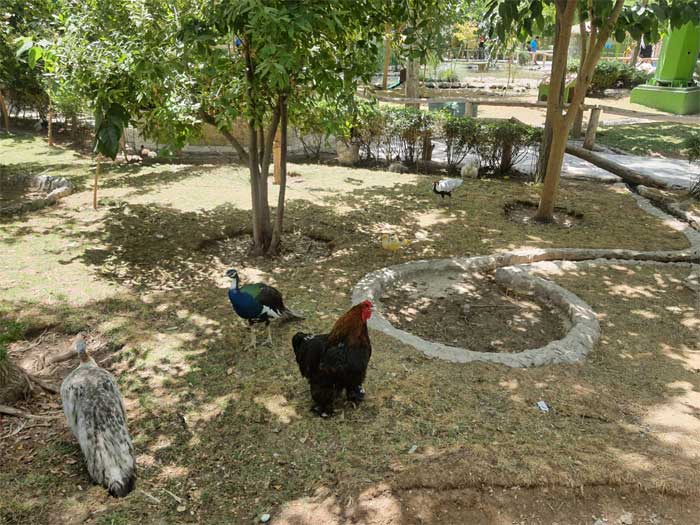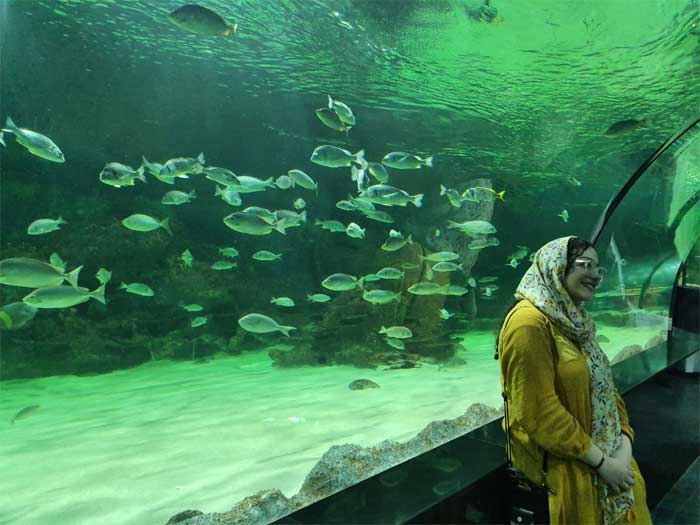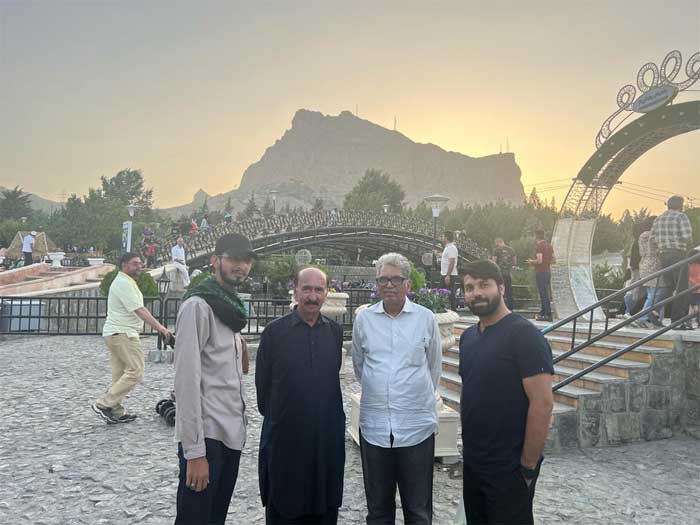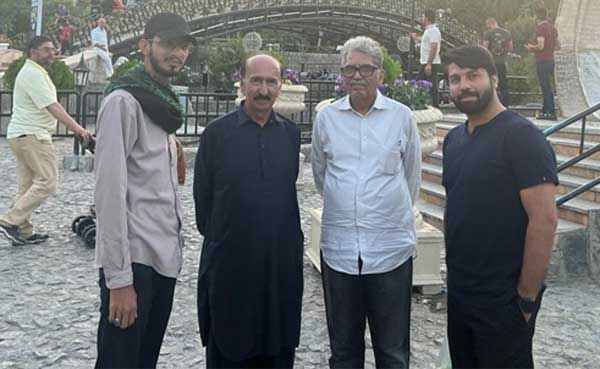The Bird Garden (Bagh-e-Parandegan)

On Friday at Isfahan, which is also called Nisf-e-Jahan, the 3-member journalists’ delegation visiting Iran with the courtesy of Iranian Cultural Center Karachi, along with Protocol Officer Ali Fatemi, our first visit was to the Bird Garden, also known as Bagh-e-Parandegan, is a renowned attraction located in Isfahan, Iran. It is a beautiful park specifically designed to house birds and showcases a wide variety of bird species. The garden is a tranquil oasis nestled amidst the bustling city, providing a serene environment for both the birds and visitors alike.
Bagh-e-Parandegan offers a unique opportunity for bird enthusiasts and nature lovers to observe and interact with a diverse range of avian species. The garden is meticulously designed with lush greenery, ponds, and aviaries, creating a natural habitat for the birds to thrive in.
Visitors to the Bird Garden can witness an array of colorful and exotic birds, including parrots, peacocks, canaries, finches, and many others. The park is not only a treat for the eyes but also a delight for the ears as the air is filled with the melodious sounds of chirping birds.
The Aquarium of Isfahan

After the Bird Garden’s we visited The Aquarium at Isfahan, located near to the Bird Garden. It is a fascinating destination that offers visitors a diverse collection of aquatic species, showcasing the rich biodiversity found in different marine ecosystems. Upon entering, visitors are greeted by an enchanting world of underwater wonders, featuring vibrant coral reefs, colorful fish, mesmerizing sea creatures, and captivating displays.
The Aquarium’s exhibits are thoughtfully designed to educate and entertain visitors of all ages. With carefully curated displays and informative signage, guests can learn about the fascinating characteristics and behaviors of various marine species. From majestic sharks to delicate seahorses, each exhibit offers a glimpse into the captivating world beneath the waves.
The proximity of the Aquarium near the Bird Garden adds to the overall experience. Visitors can enjoy the harmonious combination of land and sea, immersing themselves in the beauty of nature. After exploring the captivating marine life, one can venture into the Bird Garden to encounter an array of avian species, adding another layer of natural beauty to the visit.
Chehel Minar

Our next destination was a most historical place, The Chehel Minar of Isfahan, also known as the “Forty Columns,” and is a magnificent architectural structure that stands as a testament to the grandeur and sophistication of Persian architecture. Located in the heart of Isfahan, Iran, this iconic landmark has captivated visitors for centuries with its unique design and historical significance.
The Chehel Minar was constructed during the Safavid dynasty in the 17th century and served as a pavilion for royal gatherings and ceremonies. The name “Forty Columns” derives from the forty tall, slender columns that support the structure, creating an impressive and imposing sight. Each column is delicately carved and adorned with intricate patterns and inscriptions, showcasing the mastery of Persian craftsmanship.
The architectural style of the Chehel Minar is a fusion of Persian and Islamic influences, featuring elements such as arches, domes, and decorative tile work. The facade is adorned with colorful tiles, predominantly shades of blue and turquoise, which create a mesmerizing visual display. The intricate tile work depicts geometric patterns, floral motifs, and verses from the Quran, reflecting the rich artistic heritage of the region.
The Chehel Minar’s interior is equally stunning, with a spacious central hall adorned with exquisite paintings, plasterwork, and mirror work. The natural light filtering through the windows and skylights accentuates the beauty of the space, creating a serene and enchanting atmosphere.
Over the centuries, the Chehel Minar has witnessed significant historical events, including royal receptions and celebrations. It has also survived earthquakes and the test of time, thanks to meticulous restoration efforts that have preserved its original glory.
Today, the Chehel Minar continues to be a popular tourist attraction, drawing visitors from around the world who marvel at its architectural splendor and historical significance. It stands as a proud symbol of Isfahan’s rich cultural heritage and serves as a reminder of the city’s illustrious past.
A visit to the Chehel Minar offers a glimpse into the opulence and artistic brilliance of Persian architecture. As visitors stroll through its grand halls, surrounded by magnificent columns and intricate tile work, they can’t help but be transported back in time to an era of majestic royal courts and refined aesthetics. The Chehel Minar truly stands as a masterpiece of Persian architecture and a testament to the enduring legacy of Iran’s rich cultural heritage.
Roza-e-Zainab (S.A) Binte Imam Musa Kazim (A.S)

Roza Bibi Zainab in Isfahan, Iran, is a revered shrine dedicated to Bibi Zainab, the granddaughter of Prophet Muhammad (SAAW). She is the daughter of Imam Musa Kazim (A.S), the Seventh Imam and the sister of Imam Raza (A.S), the eight Imam. Located in the center of Isfahan, the Dargah is a place of pilgrimage for Shia Muslims worldwide. It showcases exquisite Persian and Islamic architecture with intricate tile work and calligraphy.
Inside the Dargah, visitors can find the tomb of Bibi Zainab, where her mortal remains are believed to be resting. Devotees come to offer prayers and seek her blessings. The shrine holds special significance during Muharram when Shia Muslims commemorate the martyrdom of Imam Hussain (A.S).
The Holy Savior Cathedral (Arminian Church) Isfahan

After the visit of Bibi Zainab’s (S.A) Shrine, we reached the Holy Savior Cathedral, also known as the Church of the Saintly Sisters. It is a prominent cathedral located in the New Julfa district of Isfahan, Iran. This magnificent structure serves as a symbol of the rich religious and cultural heritage of the Armenian community in Iran.
Construction of the Holy Savior Cathedral began in the early 17th century, during the reign of Shah Abbas-I of the Safavid dynasty. At that time, Isfahan was a thriving hub of trade and commerce, attracting numerous Armenian merchants who settled in the city. Shah Abbas-I granted them permission to establish a new district called New Julfa, where they could maintain their cultural identity and practice their Christian faith freely.
The interior of the Holy Savior Cathedral is equally impressive. The central dome, adorned with stunning frescoes and intricate paintings, serves as the focal point of the cathedral. The walls are adorned with beautiful religious icons, intricate woodwork, and ornate carvings. The cathedral also houses a rich collection of religious artifacts, including holy relics, manuscripts, and precious artworks.
One of the most striking features of the Holy Savior Cathedral is its belfry tower, rising high above the surrounding buildings. The tower is adorned with ornate decorations and a large clock, adding to the grandeur of the structure.
Throughout its history, the Holy Savior Cathedral has played a significant role in the religious and cultural life of the Armenian community in Iran. It has served as a place of worship, a center for religious ceremonies and events, and a gathering place for the community. The cathedral continues to be an important spiritual and cultural landmark, attracting visitors from around the world who are captivated by its beauty and historical significance.
The Holy Savior Cathedral stands as a testament to the enduring presence and contributions of the Armenian community in Iran. Its architectural magnificence and cultural significance make it a cherished symbol of religious tolerance and coexistence in Isfahan.
Koh-e-Safa (Bam-e-Isfahan)

Koh-e-Safa is a mountain located in the beautiful city of Isfahan. It is known for its stunning views, lush greenery, and the chair-lift that takes visitors up to its peak.
The chair-lift ride up Koh-e-Safa offers a unique and thrilling experience. As you ascend, you can enjoy panoramic views of Isfahan’s landscape, including the city’s iconic landmarks and the surrounding natural beauty. The chair-lift provides a convenient and comfortable way to reach the mountain’s summit while immersing you in the picturesque scenery.
Once you reach the top of Koh-e-Safa, you’ll be greeted with breathtaking vistas that stretch as far as the eye can see. The mountain offers a serene and peaceful atmosphere, making it an ideal spot for nature lovers and those seeking tranquillity.
While at the summit, you can leisurely walk along the designated paths, explore the mountain’s diverse flora and fauna, and capture memorable photos. The natural beauty and fresh mountain air provide a refreshing escape from the hustle and bustle of the city.
In addition to its natural allure, Koh-e-Safa is also home to recreational facilities, such as picnic areas and restaurants, where you can enjoy a meal or snack amidst the scenic surroundings. These amenities make it a popular destination for both locals and tourists alike.
Bam-e-Isfahan, meaning “Roof of Isfahan,” refers to the elevated vantage points in the city where you can enjoy panoramic views. Koh-e-Safa is one such location that offers a stunning viewpoint from above, allowing you to admire Isfahan’s architectural wonders, including its historic mosques, palaces, and bridges. A visit to Koh-e-Safa and experiencing the chair lift ride provides an unforgettable adventure and a chance to appreciate the natural and cultural beauty of Isfahan.




